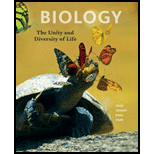
Multicelled haploid and diploid bodies form in protists that have a(n) __________.
- a. haploid-dominant life cycle
- b. diploid-dominant life cycle
- c. c alternation of generations
Concept introduction: Protists are a diverse taxonomic group of eukaryotic organisms that are unicellular, sometimes colonial, or less often, multi-cellular; it includes protozoans, most algae, and often some fungi. Some protists have a cycle dominated by haploid forms and some protists have a cycle dominated by diploid forms.
Answer to Problem 1SQ
Correct answer: Multi-celled haploid and diploid bodies form in protists that have an alternation of generations. Therefore, option c. is correct.
Explanation of Solution
Reason for the correct statement:
Protists reproduce asexually when the conditions favor their growth. They switch to sexual reproduction when they do not. Multi-cellular algae and all plants have an alternation of generations. In the alternation of generations, both haploid and diploid bodies will form.
Option c. is given as “alternation of generations”. As the multi-celled haploid and diploid bodies form in protists, they have an alternation of generations. Hence, option c. is the correct answer.
Reasons for the incorrect statements:
Option a. is given as “haploid-dominant life cycle”.
Multi-celled haploid and diploid bodies formed in protists do not have a haploid-dominant life cycle. Therefore, option a. is incorrect.
Option b. is given as “diploid-dominant life cycle”.
Multi-celled haploid and diploid bodies formed in protists do not have a diploid-dominant life cycle. Therefore, option b. is correct.
Hence, options a. and b. are incorrect.
Want to see more full solutions like this?
Chapter 21 Solutions
Biology: The Unity and Diversity of Life (MindTap Course List)
- Basidiomycota is a division of the Kingdom Fungi. They include groups such as mushrooms, and reproduce sexually through the formation of cells called basidia. Which of the following rows identifies Process 1 and Process 3 in the life cycle shown in the diagram? Select one: a. Process 1 Process 3 Meiosis Mitosis b. Process 1 Process 3 Mitosis Mitosis c. Process 1 Process 3 Meiosis Meiosis d. Process 1 Process 3 Mitosis Meiosisarrow_forwardSpores released from a mushroom’s gills are_____ . a. flagellated c. dikaryotic b. produced by mitosis d. haploidarrow_forwardAll protozoan pathogens have a _____________phase.a. cyst b. sexual c. trophozoited. bloodarrow_forward
- Protists with the capabilities to perform photosynthesis and to absorb nutrients from dead organisms are called ______________. a. photoautotrophs b. mixotrophs c. saprobes d. heterotrophsarrow_forward1)If we study septate and coenocytic hyphae of equal length from two fungi species, then the coenocytic hyphae is unique because A. It is haploid B. It has fewer pores in the wall C. It has more cytoplasm streaming d.Has cellulose in the cell wallsarrow_forwardThe figure below shows the life cycle of the fungus Neurospora. The adult stage of the Neurospora is a multicellular haploid. a) Between which two stages of the Neurospora life cycle (shown above) do most mitotic cell division oarrow_forward
- Which of the following is NOT an example of a fungal spore? A. Zoospores B. Condia C. Endospore D. Basidiosporesarrow_forwardDikaryotic cells A. contain two nuclei per cell B. produce two spores per hypha C. contain diploid nuclei D. have two hyphae per fruiting body E. contain pairs of homologous chromosomesarrow_forward25. Which of the following is the protein strip found underneath cell membrane in protists? A. Cell wall B. Cilia C. Flagella D. Pellicle E. Ribosomes 26. The majority of protists are motile. A. True B. False 27. Which of the following is a sexual reproduction mechanism found in protists? A. Binary fission B. Budding C. Meiosis D. Multiple fission E. All of the above. 28 Many protist species can switch from asexual to sexual reproduction when necessary. A. True B. False 29. Which of the following is NOT true of sexual reproduction in protists? A. Often linked to nutrient depletion B. May be triggered by environmental changes C. Often associated with cysts D. Cysts are resistant to temperature extremesarrow_forward
- Slime molds/moulds or mycetozoans is a broad term that applies to many fungus-like protists. a. In what sense is it appropriate to describe slime molds as “fungus animal”? b. Elaborate on the evolution of the slime molds into two distinct groups.arrow_forwardFind the large nucleus located near the cell. Make several outline drawings to illustrate the successive changes of 1. shape of the amoeba. Make drawings of the Amoeba you observe, and label its structures. C O O liko mer 0 AS 6 0 O Paramecium -- Paramecia are quite large, straw-colored, slipper-shaped and move rapidly, and they are thus very noticeable. If there are Paramecia in your field of view you probably will recognize them immediately. Often, however, students do have difficulty both finding a Paramecium, and after they have found one, making it move slowly enough so they can study it at high magnification. The trick to finding a Paramecium is to scan the entire slide quickly using the scanning lens. Then, if you do not find one, make a new slide and search again. Often, Paramecia tend to move to the edges of the coverslip, and even "escape" the coverslip at its edges. The trick to slowing the Paramecia is to mix a drop of methyl cellulose with a drop of the cell culture, as…arrow_forwardWhich of these organelles is not found in a fungal cell? a. chloroplast b. nucleus c. mitochondrion d. Golgi apparatusarrow_forward
